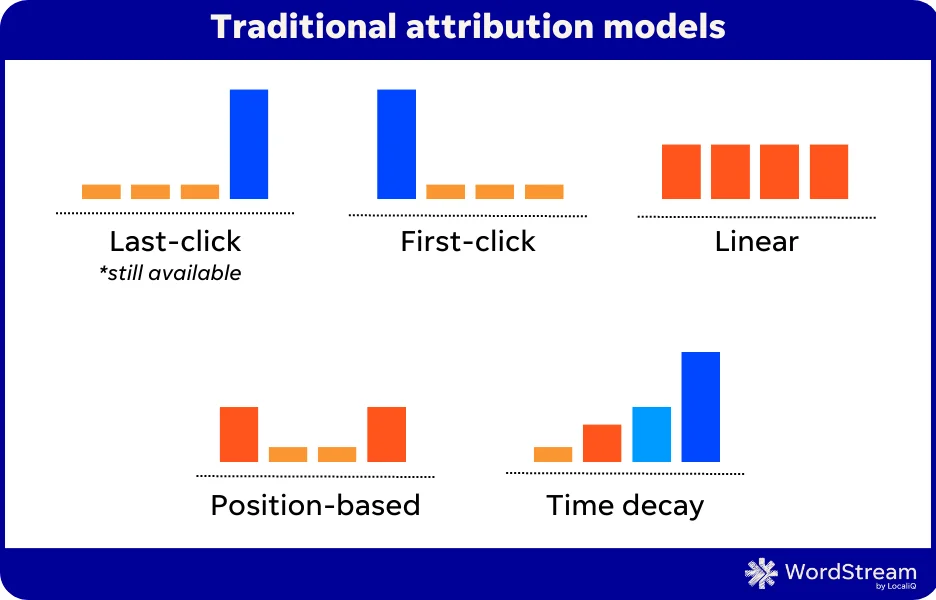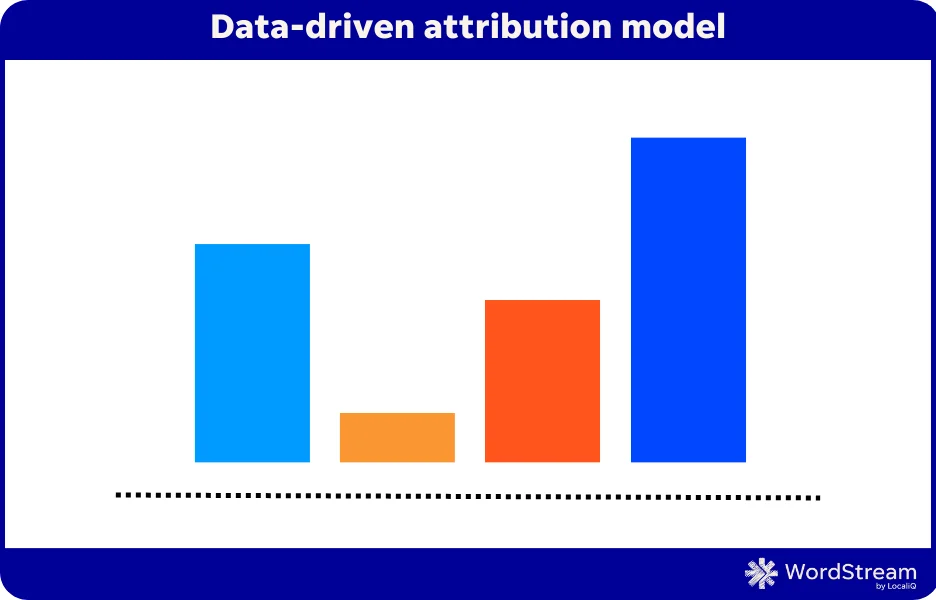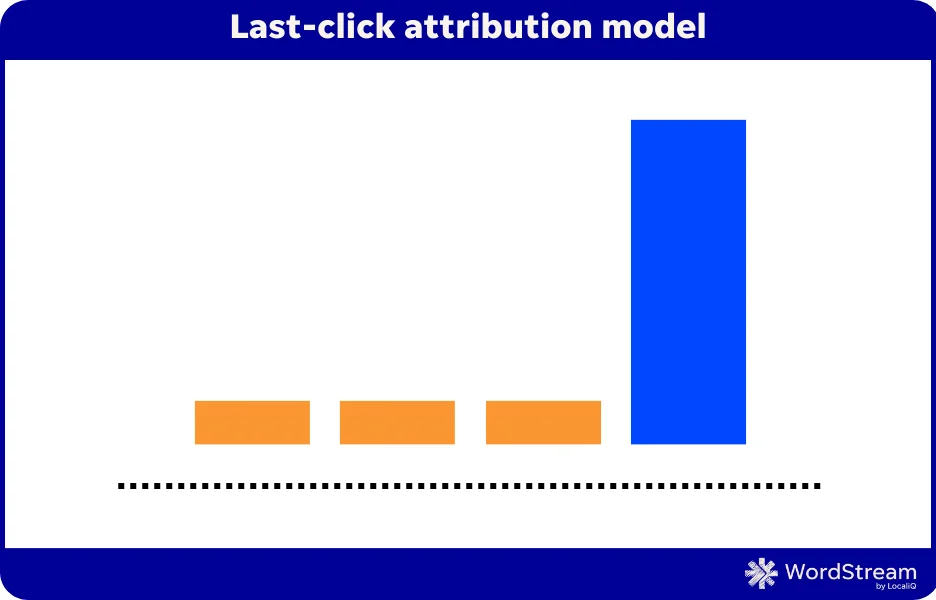Google is constantly pushing toward more automation and less advertiser autonomy on its platform. Many times, this push for the adoption of newer, more “simplified” features means the discontinuation of older ones that everyone is used to.
One of the most recent victims of this is the discontinuation of first-click, linear, time decay, and position-based attribution models.

Google announced the phase-out earlier this year, and we’re at the point where you’re no longer able to use these attribution models. If you have pre-existing conversions that you were using any of them, they will be switched to the data-driven attribution model.
So what does this mean for advertisers going forward? In this article, I’ll run through the changes and how they can affect your strategy in Google Ads.
Table of contents
- Traditional attribution models
- What is data-driven attribution?
- What is last-click attribution?
- What’s the future of Google Ads attribution models?
Traditional attribution models
Before we delve into future implications, let’s start by taking a look at how traditional attribution models tracked conversions and what the difference is between these and the data-driven and last-click models that remain available:
- Last click (still available): This model attributes all the credit to the final interaction a user has with an ad before converting.
- First click: First-click attribution gives all the credit to the first interaction in the customer journey, regardless of subsequent interactions.
- Linear: The linear model evenly distributes credit across all touchpoints throughout the customer journey.
- Time decay: Time decay attribution assigns more credit to interactions closer to the conversion and less to earlier interactions.
- Position-based: This model gives more credit to the first and last interactions, while the middle interactions receive less credit.
🛑 Worried you’re wasting spend in Google Ads? Find out with a free, instant audit >> Google Ads Performance Grader
What is data-driven attribution?
To understand why Google would discontinue traditional attribution models, let’s take a deeper look at the data-driven attribution model.
Data-driven conversion tracking in Google Ads is an advanced method of tracking and attributing conversions to specific keywords, ads, and campaigns based on historical data and machine learning algorithms. This tracking system aims to provide advertisers with more accurate insights into the effectiveness of their advertising efforts.

How data-driven attribution works
Here’s how data-driven attribution works:
- Data collection: Google Ads collects a wealth of data related to user interactions with your ads and website. This includes click data, user behavior on your website, and conversion data (e.g., purchases, form submissions, phone calls).
- Machine learning algorithms: Google uses machine learning algorithms to analyze this data and identify patterns and trends. It looks at various factors, such as the time of day, device type, location, and more, to understand what drives conversions.
- Attribution modeling: Data-driven conversion tracking employs advanced attribution modeling techniques to assign value to different touchpoints in the customer journey. It considers the entire conversion path, including multiple interactions with your ads before a conversion occurs.
- Conversion prediction: Based on historical data and machine learning insights, Google Ads predicts the probability of a conversion happening for each click on your ad. This prediction helps determine which ad clicks are more likely to lead to a conversion.
- Optimization: Google Ads uses this predictive data to optimize your bidding strategy. It may adjust bids in real-time, allocating more budget to keywords and ads that are more likely to result in conversions. This can help you maximize the return on investment (ROI) of your advertising spend.
- Performance reporting: You can view detailed performance reports in Google Ads that show how different keywords, ads, and campaigns are contributing to conversions. This information helps you make informed decisions about your advertising strategy.
Overall, and on paper, at least, data-driven attribution is the future of conversion tracking. And while I’m not in favor of fewer options for conversion tracking, I am in favor of data-driven attribution as a way to track your results.
⚡️ Is your Google Ads account set up for success? Find out >> The Last Guide to Google Ads Account Structure You’ll Ever Need
What is last-click attribution?
A silver lining for traditional attribution advertisers is that last-click hasn’t gotten the axe…yet. For those less familiar with it, last-click conversion tracking in Google Ads is a simplified attribution model that assigns all the credit for a conversion to the last ad click a user made before converting. This means that if a user clicks on multiple ads from different campaigns or keywords during their customer journey, only the final click is considered responsible for the conversion.

How last-click attribution works
Here’s how last-click attribution works and why it is still used despite the removal of traditional attribution models:
- User interaction: A user interacts with multiple touchpoints related to your ads. For example, they might click on an ad in a search result, then see a display ad, and finally, return to your website directly through a bookmark.
- Conversion event: The user ultimately converts, such as making a purchase, signing up for a newsletter, or completing a form on your website.
- Credit assignment: In last-click attribution, all the credit for the conversion is assigned to the very last click that brought the user to your website. In the example above, the direct visit would receive 100% of the credit for the conversion.
Pros and cons of last-click attribution
Here are some pros and cons of using last-click attribution to track conversions.
Pros
- Simplicity: Last-click attribution is straightforward and easy to understand. It provides a clear and simple view of which ads or keywords are driving immediate conversions.
- Historical use: Last-click attribution has been the default and most commonly used attribution model for a long time. Many advertisers are familiar with it, and it’s the default setting in many reporting platforms.
- Data availability: In some cases, especially for smaller advertisers or those with limited tracking capabilities, last-click attribution may be the only practical option due to data limitations.
- Alignment with direct response goals: For businesses focused on direct response advertising and immediate conversions, last-click attribution may align well with their goals.
Cons
- Inadequate for complex journeys: In the modern digital landscape, customer journeys are often complex, involving multiple touchpoints across various channels and devices. Last-click attribution ignores the influence of all but the last click, providing an incomplete picture of user behavior.
- Unfair distribution of credit: It can unfairly reward the last-clicked ad, even if earlier clicks played a crucial role in the user’s decision-making process.
- Misallocation of budget: Relying solely on last-click attribution can lead to misallocation of ad spend, as you may overinvest in keywords or campaigns that only appear to perform well due to being last in the click path.
Despite these limitations, last-click attribution is still used because it’s familiar and easy to implement.
What’s the future of Google Ads attribution models?
For the time being, you have the option to use Google’s data-driven or last-click attribution models. It may come down to personal preference, or how you wish to view the performance information.
My personal opinion that may clash with other experts in the space is that I love and generally prefer last-click. The reason I love it is for its simplicity and straightforwardness for lead generation. We can tie exactly which keyword and ad drove which lead. For me, the scattered attribution and fractions of conversion attribution is generally confusing to many clients. Click, lead, opportunity, sale.
However, I have been using data-driven attribution for some time now. I feel as though it will become the permanent option at some point here, but I also take into consideration that the data-driven model may fuel more intelligent bidding on the machine-learning side. In some respects, you have to embrace these steps forward in artificial intelligence and digital advertising, however forced and unnecessary they may seem.
At the end of the day, you need to choose the available attribution model that works best to help you measure and track your performance so you can reach your marketing goals.







